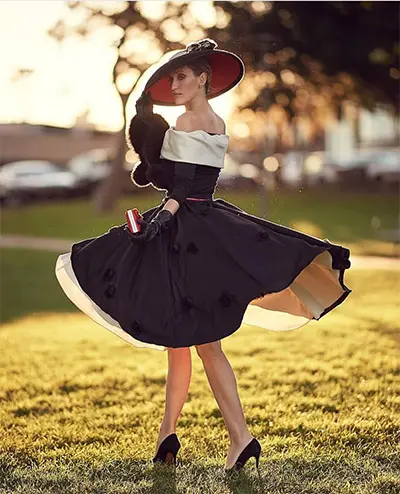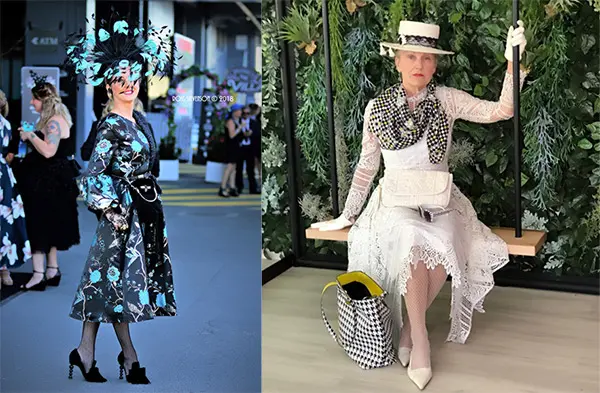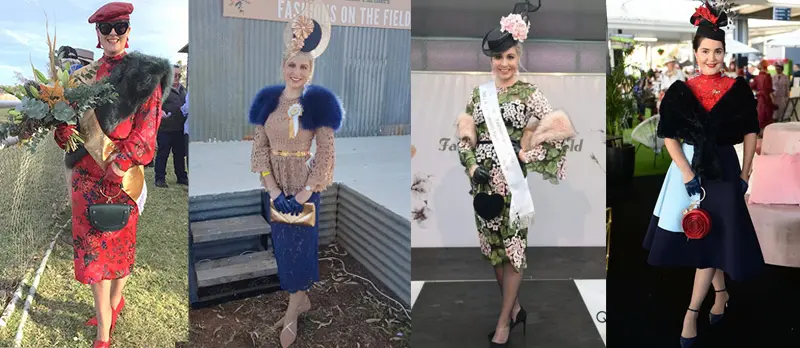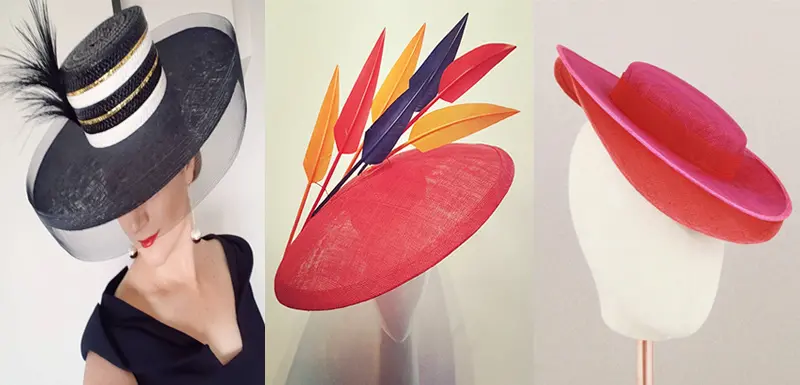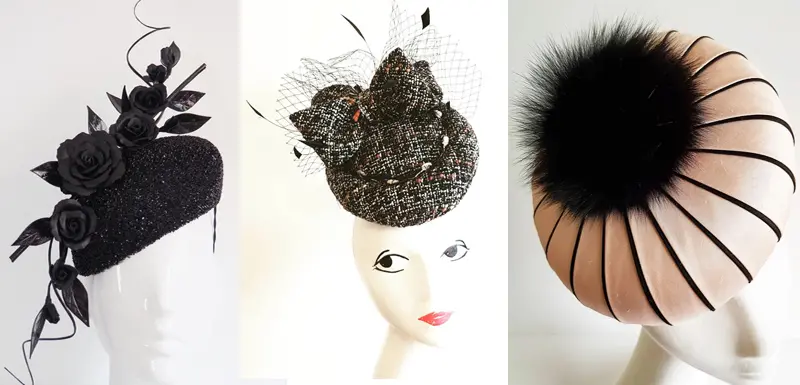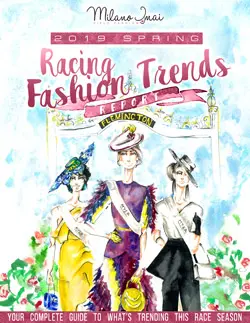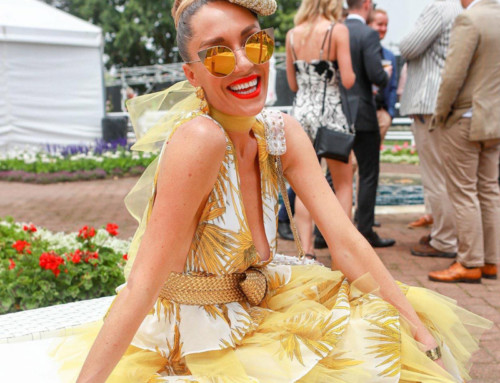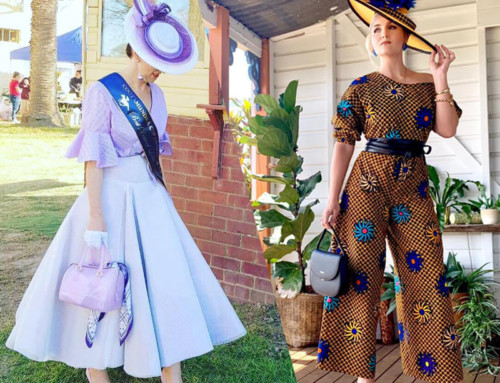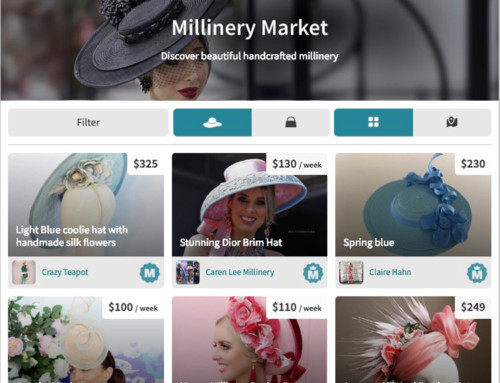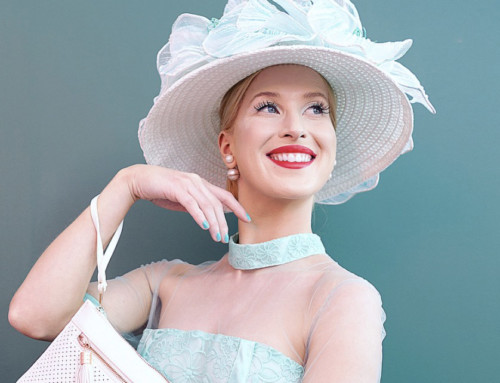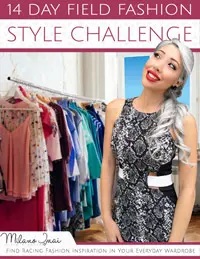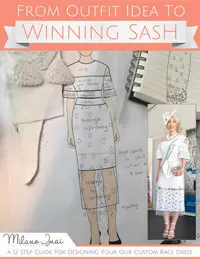Seasonal changes are fun for the racing fashion enthusiast as they provide us with the opportunity for experimentation and creativity. Unlike our northern hemisphere counterparts, racing fashion in Australia is divided into two seasons, Spring/Summer (S/S) and Autumn/Winter (A/W).
It is important to abide by the seasonal changes in fashion as judges of Fashions on the Field are often strict on these rules, in terms of fabrications of clothing, millinery and accessories.
When you’re just starting out, it can be tricky knowing what is and isn’t appropriate for the season. So, in this post I’ll shed some light on the key differences between the seasons.
Contents
Clothing Fabrications
Spring/Summer
In S/S, opt for lightweight fabrics, such as cotton blends, lace, sheer fabrics, silks, linen, chambray, seersucker, jacquard, chiffon, tulle or rayon. Almost any light-weight fabric will be fine. You can opt for a heavier fabric, as long as it doesn’t look too wintery, such as tweed or wool.


Fabrics above all available from www.tessuti-shop.com
Autumn/Winter
In A/W, a thicker fabric such as wool, velvet, heavier laces, tweed, flannel, faux fur, silk (silk is great for winter because it keeps you warm, but still breathes) corduroy, jacquard, leather, suede, cashmere etc. are the most popular choices.


Fabrics above all available from www.tessuti-shop.com
Note here though, a fabric can be interchangeable between S/S and A/W by choosing the appropriate colour for the season.
For example, you may still wear a light-weight cotton in winter if it’s in a rich winter tone, like emerald green or burgundy. The same goes for the reverse, a winter fabrication such as leather, could be made suitable for S/S with the use of a lighter colour such as nude, cream or pink or a floral print.
In the following pic, Lindsay is wearing tulle, typically a S/S fabric. However, she has made it winter appropriate, by choosing a rich purple colour and pairing it with a thick over coat dress.
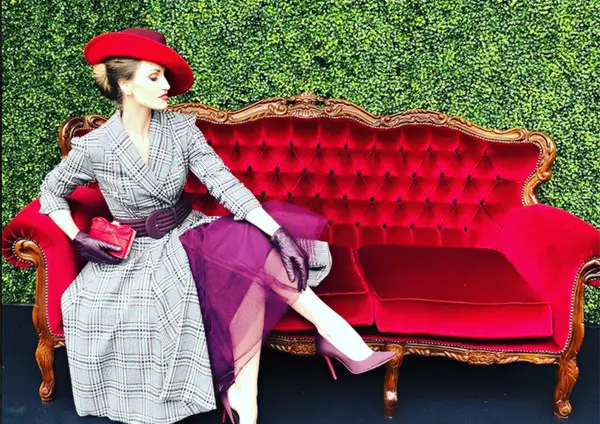
Image credit: Lindsay Ridings
Outfit Silhouettes
Spring/Summer
In S/S you have a bit more lenience in what styles to wear. You can wear off shoulder, a variety of sleeves; such as no sleeve, short sleeve, long sleeve (if you won’t be too hot) or one shoulder. The length of your dress can vary from a midi length to knee-length.
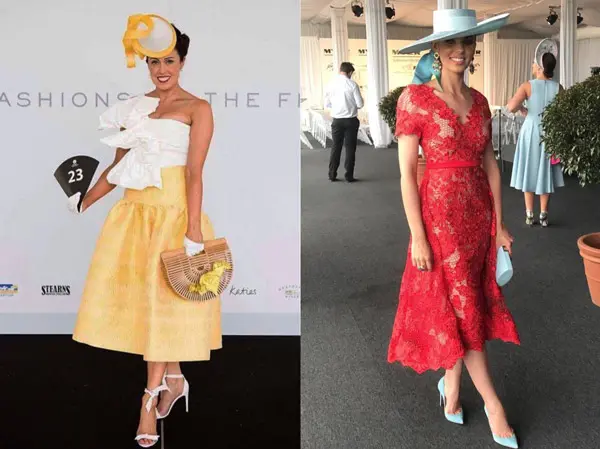
Image credit: @emscodellaro, @itsannabeldavy
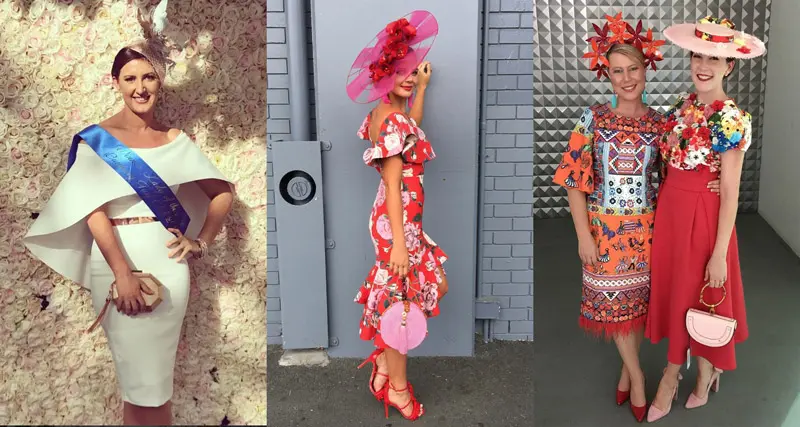
Image credit: @stace_reynolds03, @gracyn_marsterson23, @airs.and.graces
Autumn/Winter
For A/W it is best to have a sleeve; long sleeve is favourable in the cooler states. Personally, I love being able to play around with different styles of sleeves; your sleeve can be the stand out feature in your outfit.
You can wear off shoulder if you can style it appropriately, but it has to be made winter appropriate, like Lindsay has done below. Or you could wear a fur stole over the shoulders. If you’re just starting out though, may be best to try a covered shoulder just to be safe.
The dress silhouettes are much the same as in S/S, but I would keep the length a little longer than knee length, to combat cold weather.
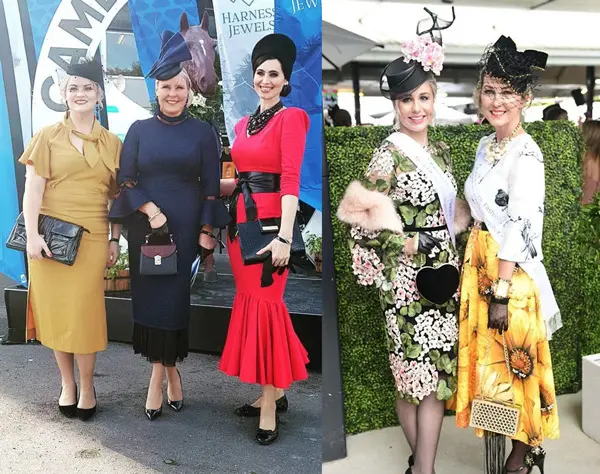
Image credit: @monika_neuhauser_millinery, @bicyclebob45 photo of @amandamacor and @shannleigh__
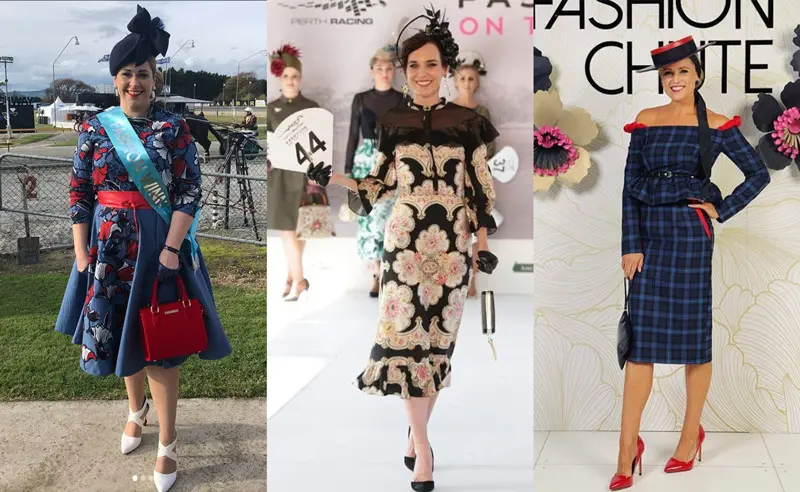
Image credit: @katiemcnamara85, @elizabeth_winlo, @alicebright__
Pantsuits are a super fun option for the races and can be worn in both S/S and A/W. You can style a pant suit to look summery or warm.
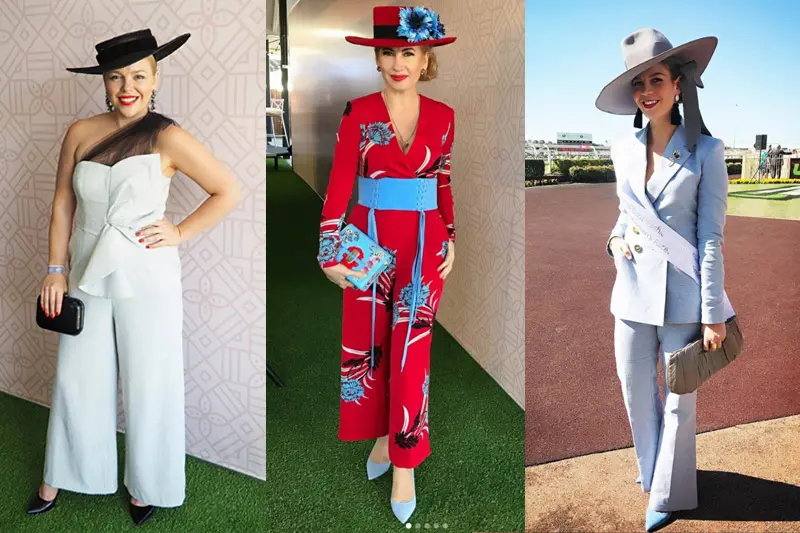
Image credit: @allportmillinery, @queenofhatsbrisbane photo of @style_by_annalucky, @kelli_louise
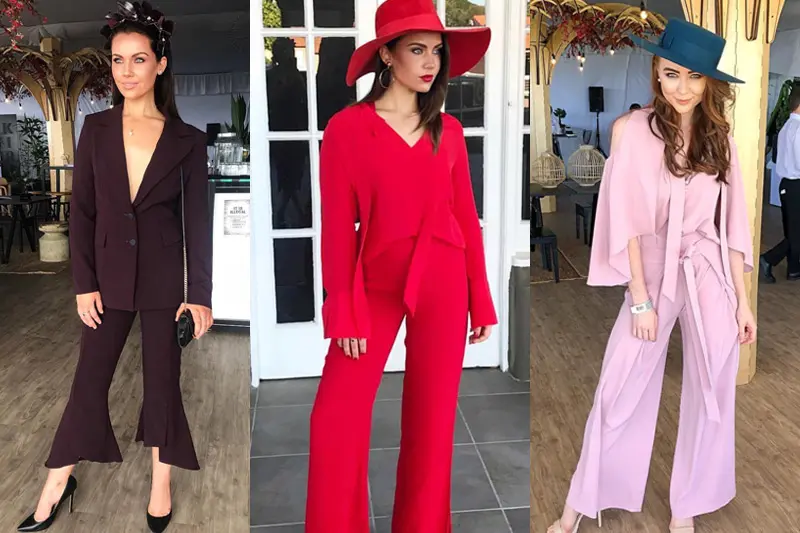
Image credit: @courtneythorpe_xx (left two), @_tess.alexander_ (right)
Accessories
Accessories are where you can really give your outfit the season appropriate feel. You can basically style a variety of dresses to look S/S or A/W appropriate with the right accessories. I’ve seen many ladies wear a dress for a S/S event and then style it up later in the year to be A/W appropriate.
Emma wore this stunning Alex Perry nude dress to Magic Millions in January, with sinamay twist millinery. Then accessorised it into a winter vibe for Toowoomba, by adding a burgundy leather cropped jacket, leather boater with flower details and gloves.
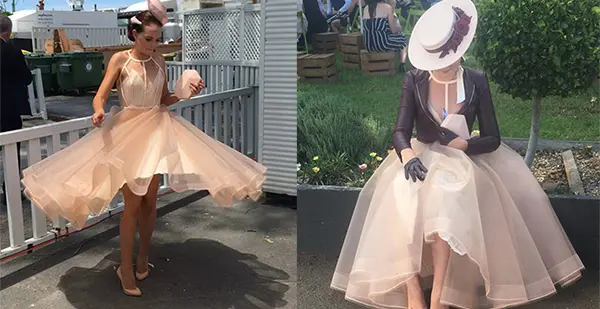
Image: Emma Clarke
Emma also shows us how to style a lace dress in lighter colours often worn in S/S to make it appropriate for the cooler months. A cropped jacket and leather accessories does the trick nicely.
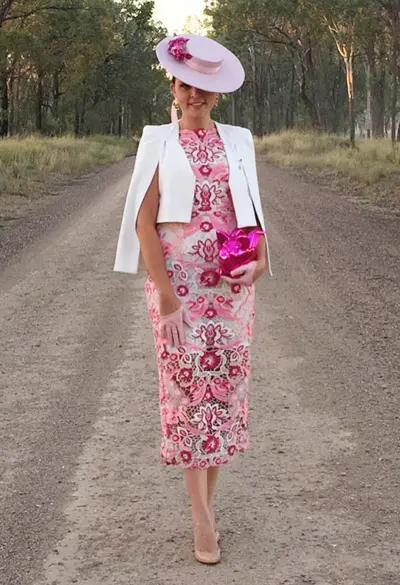
Image credit: @missemmac in @makermillinery
Spring/Summer
Your accessories for S/S can be made from a variety of fabrications. For gloves, if you choose to wear them, you have the choice of sheer fabrics, tulles, leather (trans-seasonal), lace and silk. Avoid wearing wool or velvet gloves as these are seen as winter fabrications and will not suit your look.
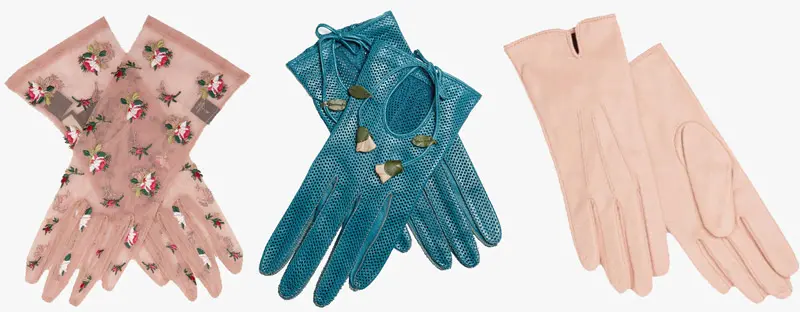
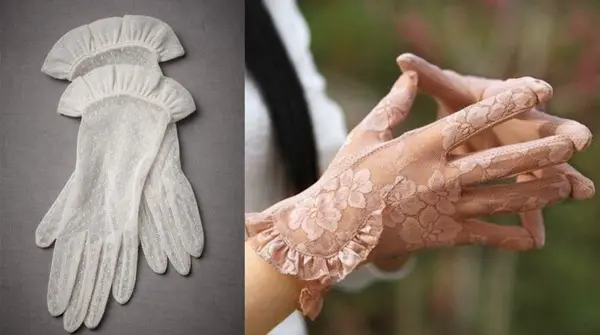
Your shoes can be open toe, strappy or closed toe in leather, suede, silk or any fabrication really.
Bags and clutches are much the same, with leather being trans-seasonal, straw and silk or even hard cases like plastic or pvc are popular.
Autumn/Winter
It used to be a popular rule that you must wear pantyhose in A/W. These days, judges are less strict and, unless it is in the rules of criteria for the FOTF competition you are entering, you can ditch them.
If it’s a very cold day though, I suggest wearing them. It may suit the ‘appropriateness for the day’ criteria and, also, there is nothing worse than shivering your way up on stage, teeth chattering.
I should note here, your pantyhose don’t just have to help with the weather because, recently, they can be found in all sorts of funky prints and colours, adding a quirky touch to your look.
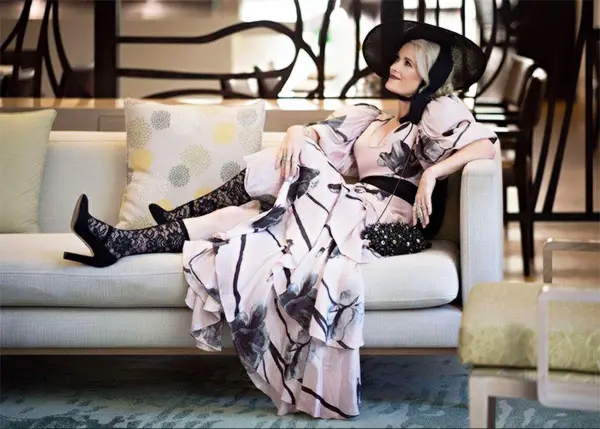
Image credit: @wendellt image of @lisamarch1
And for those of you who like to try new trends, how about trying some sheer socks with your heels!
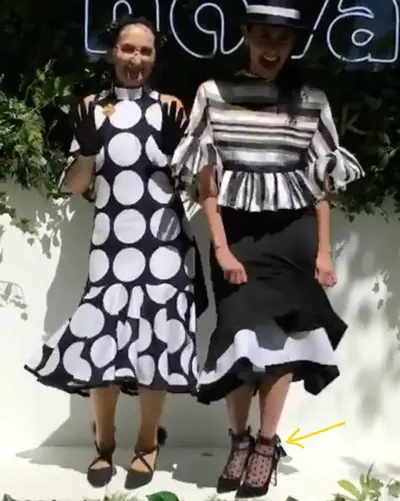
Image credit: @viviana_croker
As for your shoes, always wear a closed toe heel. Open toe will lose you marks in Winter.
You can choose to wear a boot too. I have heard a few ladies ask whether a closed toe sling back shoe is appropriate… that would depend on the judges, but generally, I would leave that style for S/S.
Gloves can be a fantastic accessory to give you that added winter styling feel to your outfit. You don’t have to wear them if they don’t go with your outfit, but you could always consider holding them in your hand, or over your clutch. Fabrications for gloves in winter are wool, leather, felt, satin, silk, lace or velvet.
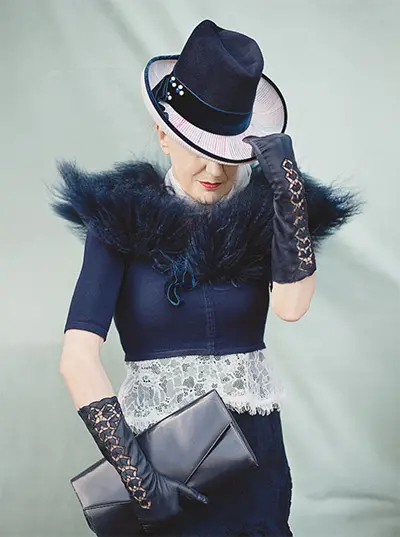
Image credit: @wendellt photo of @suzanne.suzette
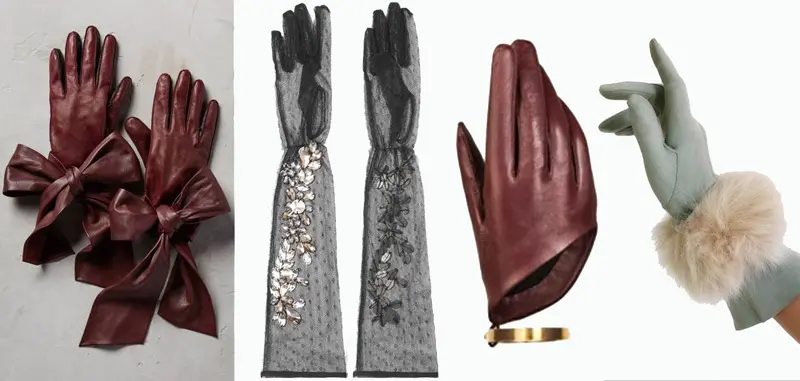
Can you guess what the hottest trend this A/W is? It’s faux fur stoles used to accessorize all outfits whether they be draped over the shoulder, worn as a shawl or wrapped over one arm.
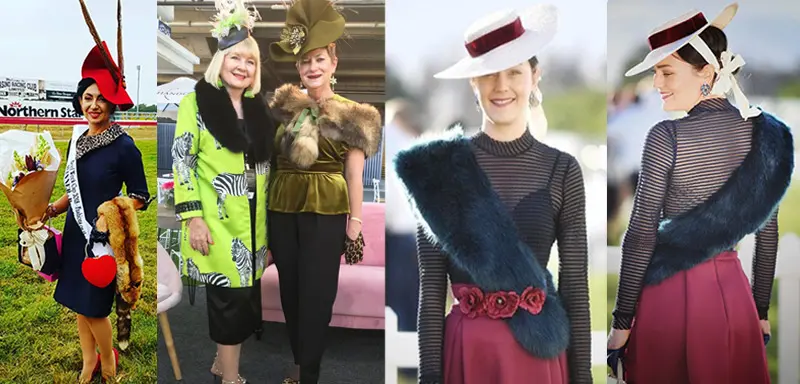
Image: @casinoracingclub, @thequeenofhatsbrisbane, @wendellt photo of @trackfillies
I had to include this photo too because I thought it was such a nice touch having a little feature of faux fur around the neck.
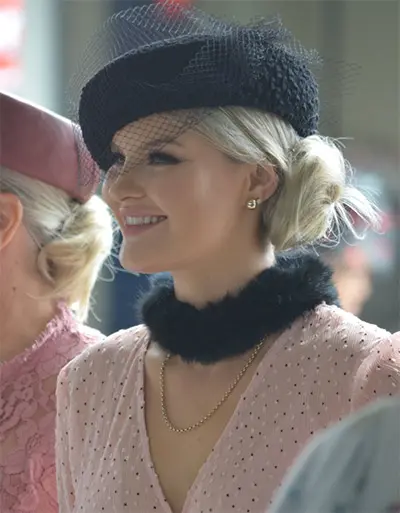
Image credit: Andrew Cliff photo of @eleanorcampbell
Millinery
Is there such thing as a S/S or A/W shape?
No there isn’t. However, there are some hat shapes that are more commonly seen in different seasons. For example, in A/W, boaters, fedoras, pillbox styles and berets are more popular. In S/S, you might see more perchers, structural pieces, crowns and halos.
You can wear any shape hat in any season. It is the fabrication and colours used that determines the season. It is important to take note of the fabrications for the different seasons as unlike the fabrications for clothing, the rules for these are much stricter.
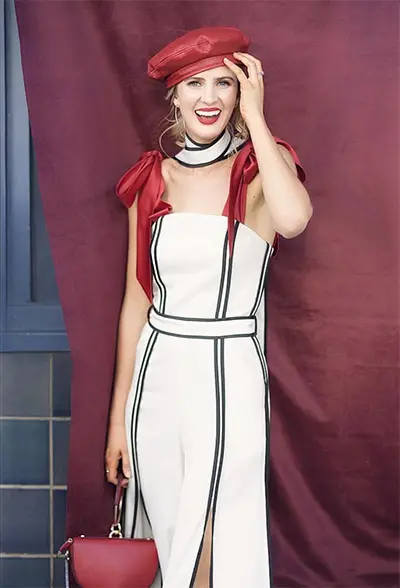
Image credit: @wendellt photo of @courtneymoore
Above, Courtney is wearing a beret, which is typically seen in A/W. However, she has paired it with a S/S outfit. The leather is trans seasonal, and works well with her styling.
Let’s take a look at individual fabrications used in millinery, to see which season they can be worn in…
Leather
Leather is trans-seasonal and can be worn in both S/S and A/W. Select appropriate colours to match the season; brighter colours in S/S (i.e. yellow, pink, blue, orange, green, white) and rich winter tones for A/W (i.e. burgundy, red, emerald, navy, brown, burnt orange, deep purple, black).
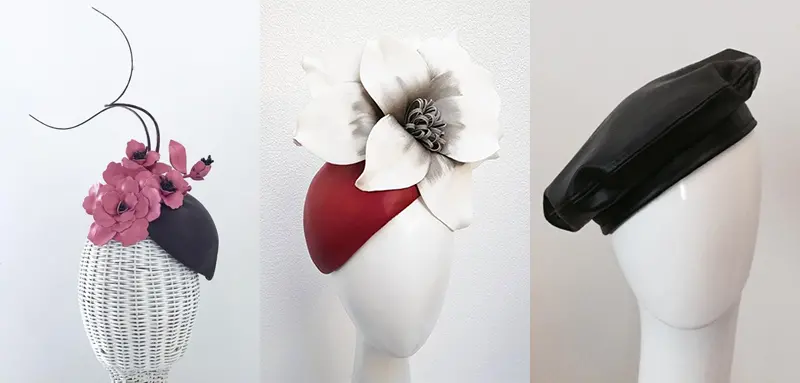
Image credit: @makermillinery, @cessiah.alice.millinery, @mooremillinerydesigns
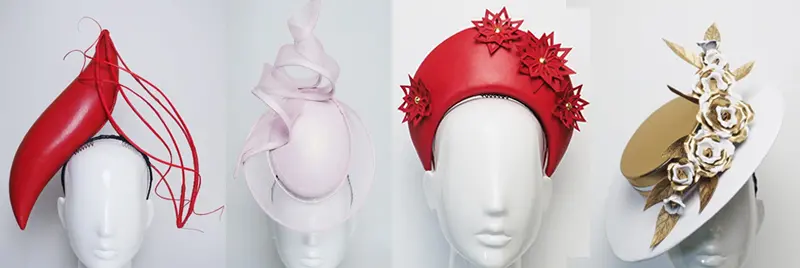
Image credit: @allportmillinery
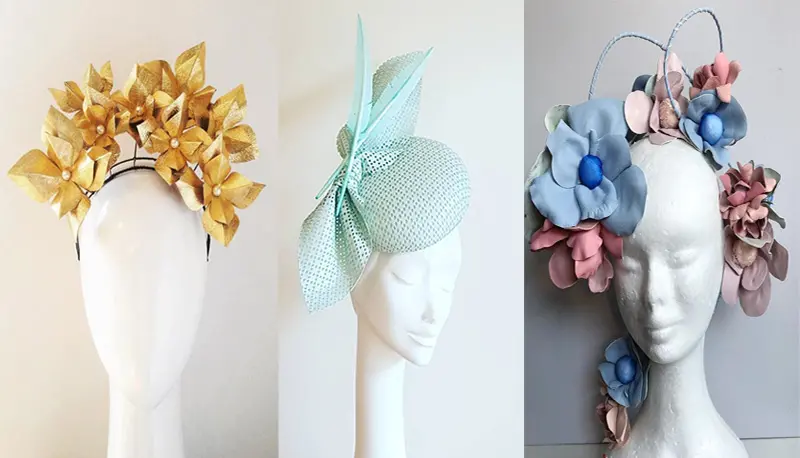
Image credit: @lovelotus, @monika_neuhauser_millinery, @misslouisemillinery
Felt / Fur
This is a definite A/W-only fabrication for millinery. In FOTF, you would be marked down if you wore a felt hat in Spring. Felts come in so many beautiful colours and look fantastic worked into a variety of shapes from fedoras, boaters, turbans and pillbox styles.
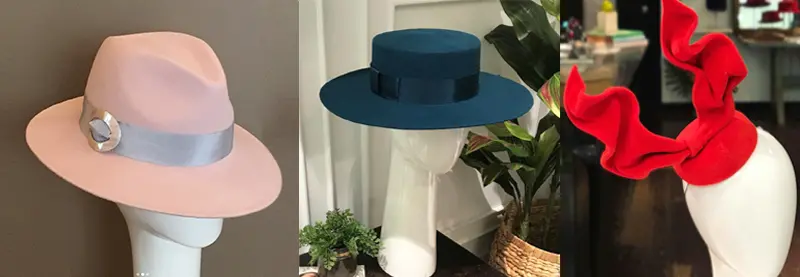
Image credit: @mooremillinerydesigns, @martina_mcgrath_millinery, @felicityboevinkmillinery

Image credit: @monika_neuhauser_millinery, @bellindahaase, @elsac.hats, @makermillinery
Straw / Sinamay
The perfect lightweight fabrication for S/S, straw and sinamay cannot be worn in A/W. This fabric is also used to make a variety of silhouettes and is easily mouldable. It can also be dyed almost any colour. Straw and sinamay are the most common fabrication used in bases.
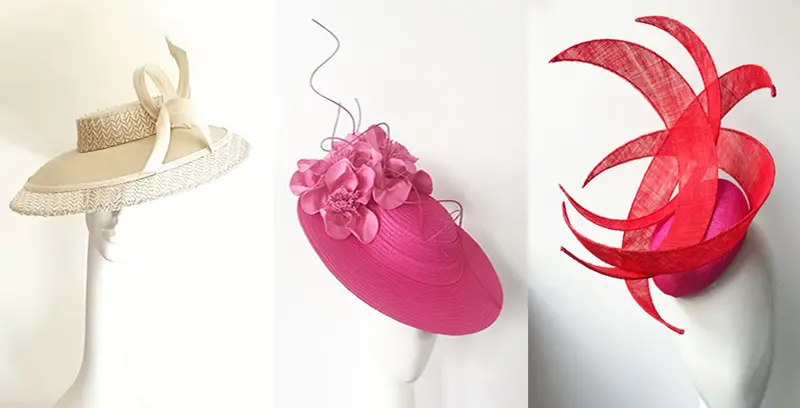
Image credit: @monika_neuhauser_millinery, @clairehahnnz, @designsbyshimmer
Fabric Covered
Hats can be made from various materials and then covered in a fabric. Your choice of fabric will determine if it is S/S or A/W appropriate. A thicker fabric with a winter colour can be used in A/W and something bright and vibrant is fine for S/S.
If you have a base blocked in a S/S fabrication such as sinamay, you can cover it to make it A/W appropriate with a fabric such as wool or tweed, as long as you cannot see any of the sinamay.
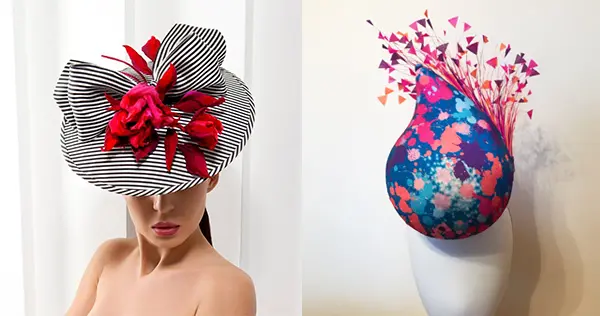
Image credit: @olgasmarkinamillinery, @designsbyshimmer
Jinsin
Jinsin is a woven straw fabric and, therefore, used in S/S. Jinsin is favoured for its sculptural qualities and you can also fray the edges, which looks really cool.
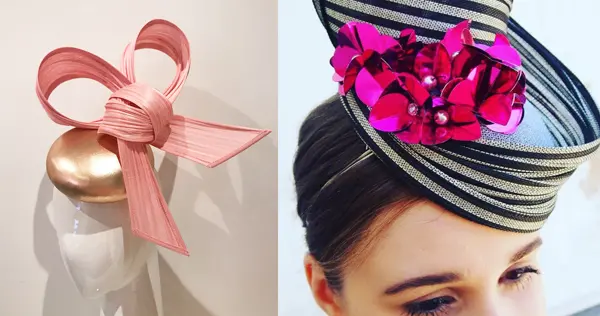
Image credit: @designsbyshimmer, @mohdeest_millinery
Eva Foam
A lightweight foam that is easy to mould, eva foam has gained quite a bit of popularity amongst milliners. Eva foam is thought to be both S/S and A/W appropriate.
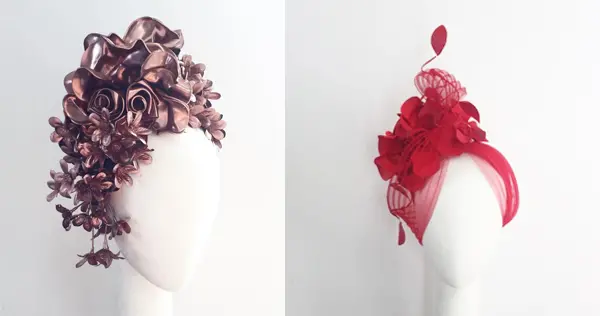
Image credit: @clairehahnnz
Silk / Silk Abaca
Silk abaca is a fabric made from silk and abaca fibre. It is popular due to how beautifully the fabric holds colour and can have a beautiful sheen to it. Silk Abaca is a S/S fabrication due to its light weight and straw like appearance.
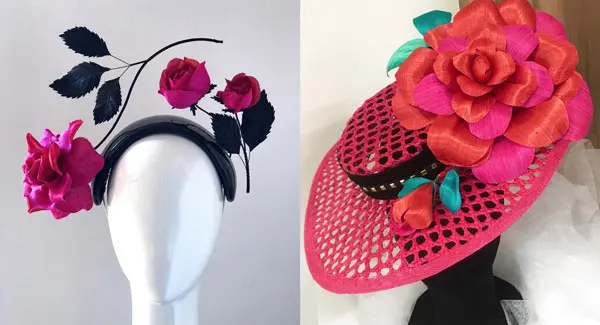
Image credit: @lovelotus, @sweetpeafinery
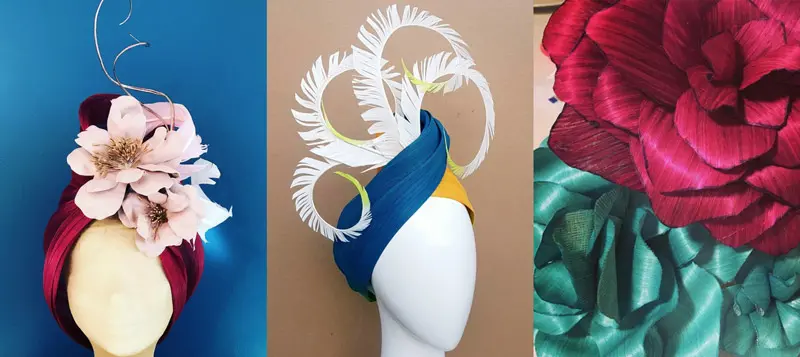
Image credit: @misslouisemillinery, @peacockmillinery, @marjoribanksmillinery
Velvet
Velvet, as I’m sure most of you can guess, is an A/W fabrication. Velvets look expensive and presents a lovely textured appearance, especially printed velvet.

Image credit: @bellindahaase, @martina_mcgrath_millinery, @designsbyshimmer, @meredithmcmastermillinery
Perspex / Thermoplastic
Perspex and plastic hats are appropriate for both S/S and A/W. The deciding factor is the fabrications you choose to pair it with, so select something to suit the season.
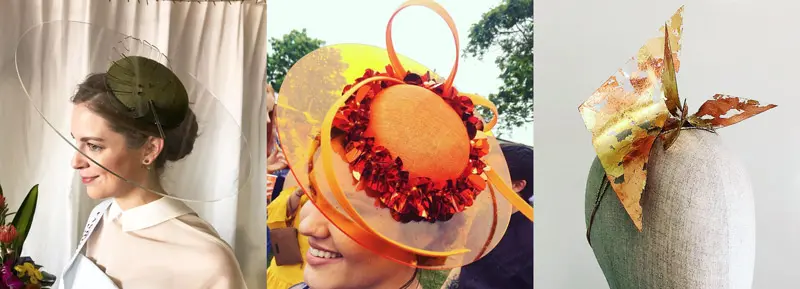
Image credit: @makermillinery, @mohdeest_millinery, @mohdeest_millinery
Raffia
Raffia is a fun natural fibre to work with as it is strong, durable and easy to dye. It is only to be worn in S/S.
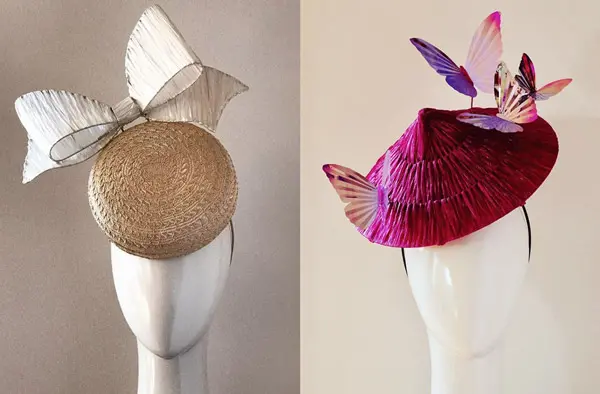
Image credit: @lovelotus, @lovelotus
Metals
Metal fabrics such as aluminium and metal sheets can be used in millinery to create interesting and unusual designs. Metals are trans-seasonal.
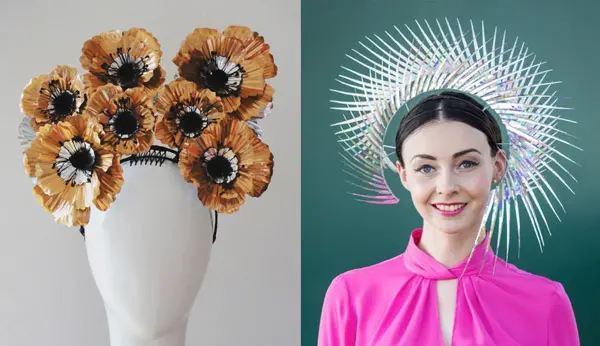
Image credit: @lovelotus, @lovelotus, @mooremillinerydesigns
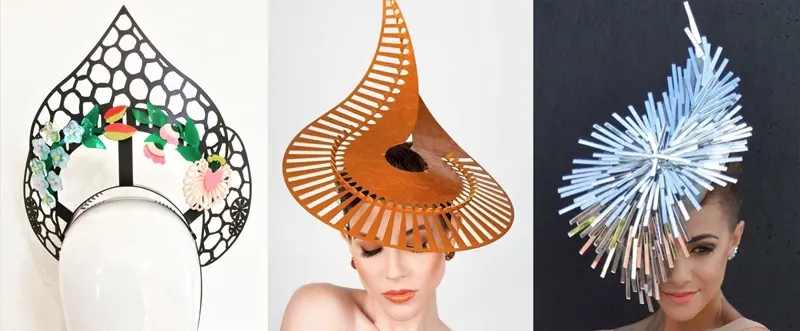
Image credit: @joanna_roberts_design, @joanna_roberts_design, @ana_bella_millinery
Crinoline
I love the effect of crinoline as a trim for millinery. In my opinion, crinoline is appropriate for both S/S and A/W and is a beautiful touch to add depth and contrast to other fabrications.
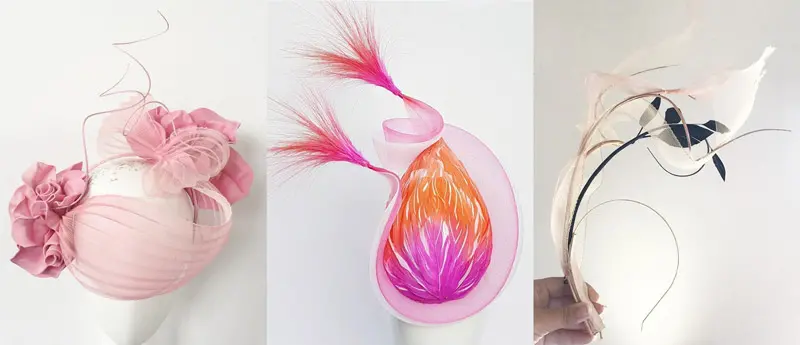
Image credit: @clairehahnnz, @peacockmillinery, @makermillinery
Braid
Braid is usually made from woven strips of cellophane and is a S/S fabrication. Braids can be sewn together to form a base of a hat, or used in strips with wire sewn in to create shapes.
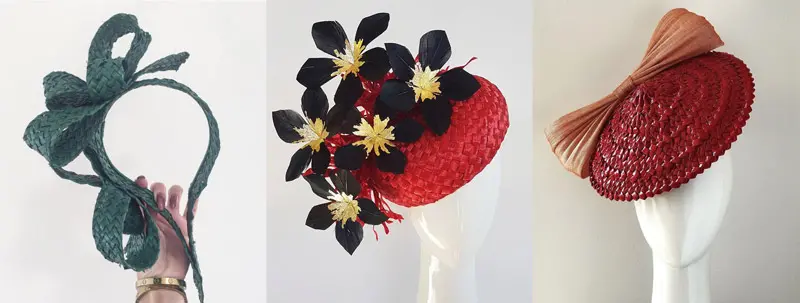
Image credit: @clairehahnnz, @peacockmillinery, @lovelotus
Veiling
Veiling, a very big trend this year, is suitable for both S/S and A/W. Choose a lighter colour veil for S/S and a heavier, darker veil for A/W. Veiling can be worn over the face or as part of an embellishment on a hat.
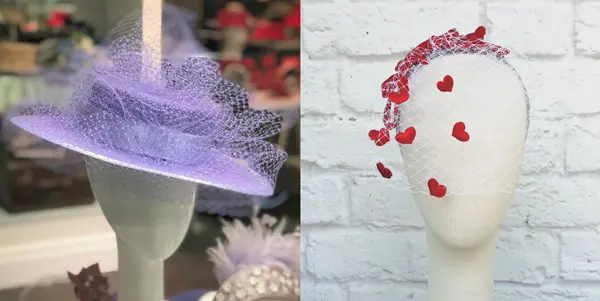
Image credit: @felicityboevinkmillinery, @sweetpeafinery
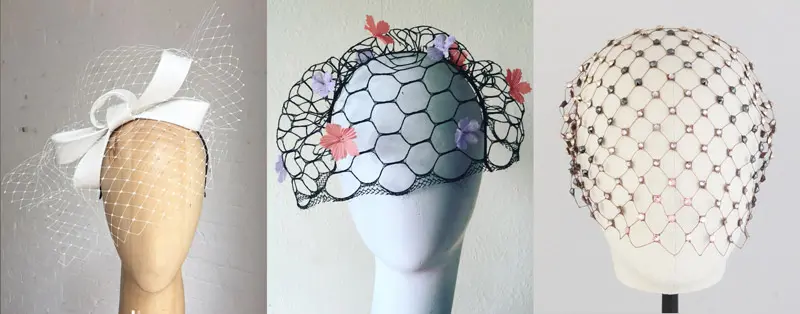
Image credit: @awongolding, @janestoddartmillinery, @renykestel
Embellished
Stones and embellishments can be used in headbands and crowns in S/S or A/W. A jewelled headband in emerald, deep blue and burgundy would look stunning in A/W, whereas, light coloured embellishments will shine in S/S.
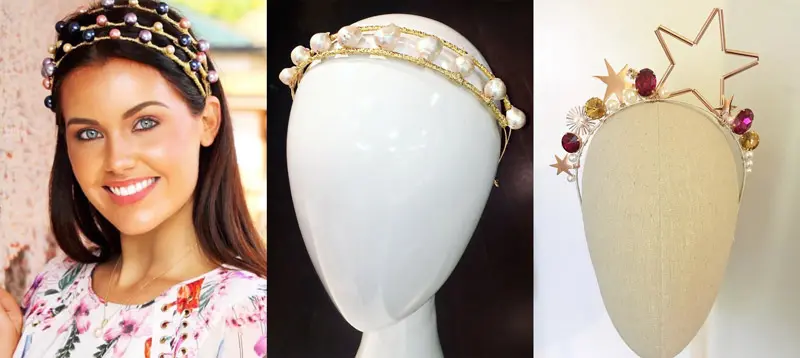
Image credit: @felicityboevinkmillinery , @felicityboevinkmillinery, @ladyofleisuremillinery
Feathers
Feathers are a trans-seasonal fabrication perfect for embellishing hats, or worn alone as a structural piece. Feathers can be cut and dyed into numerous styles and are a lot of fun to play around with.
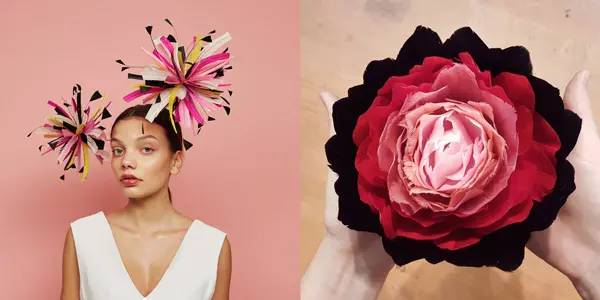
Image credit: @awongolding, @peacockmillinery
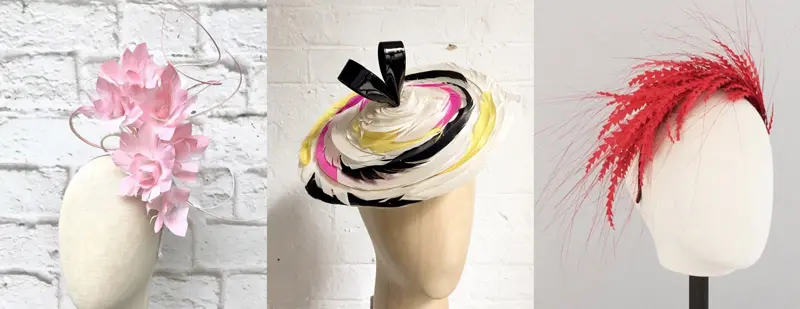
Image credit: @sweetpeafinery, @awongolding, @renykestel
Mesh
Stiffened mesh is often used in millinery and typically for S/S, however, I have seen a small trim added to a leather piece for an A/W look. Just a touch may be overlooked if it is mistaken for a mesh made of leather or plastic.
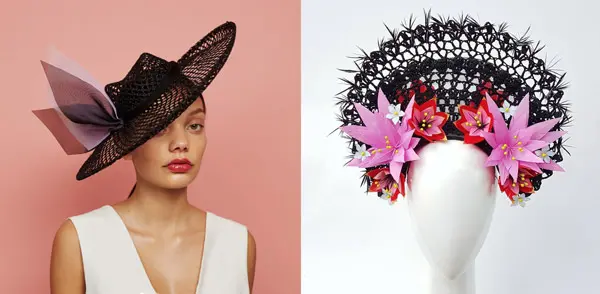
Image credit: @awongolding, @peacockmillinery
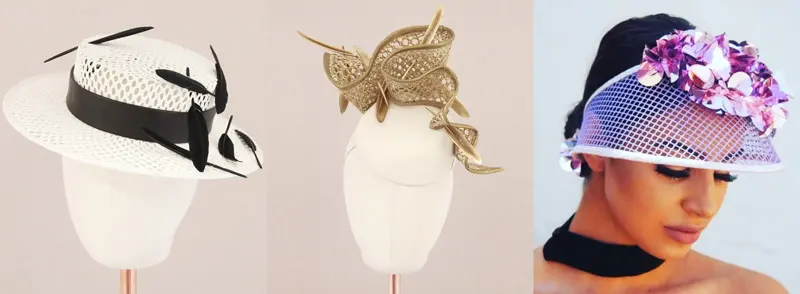
Image credit: @renykestel (left two), @mohdeest_millinery (right)
To make it easy to find a season appropriate hat, did you know Millinery Market lets you filter hat listings by S/S or A/W and by fabrication (leather, sinamay, etc)?
What if it’s hot where I live? Do I still need to abide by the Seasons?
In Australia, it is not uncommon to live somewhere that feels like summer all year round.
A trick to combat this dilemma is to abide by the seasons fabrications, in terms of millinery and accessories, (closed toe heels, leather clutches etc) but have your outfit in a light weight fabric.
Most race clubs in the warmer areas will often state whether FOTF entrants are to dress in A/W attire, or it they are more lenient. Always best to call or email the race club directly. They’ll be happy to guide you.
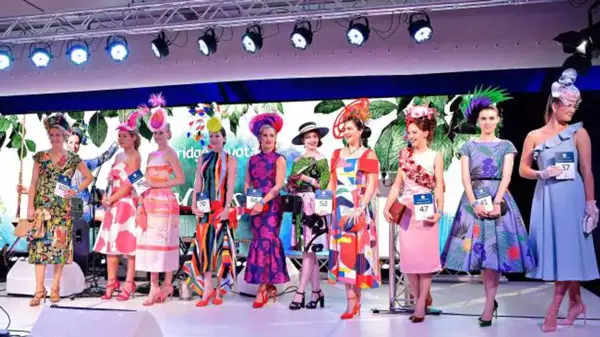
Ladies Day Top 10 in Darwin in July. Image credit: ntnews.com.au, photo by Michaei Franchi
Darwin Cup is held in August, but as it is still very hot in Darwin, ladies wear S/S attire.
Hopefully you find this post helpful when planning your next season-appropriate outfit.
For more tips on dressing for Autumn/Winter, have a read of this post: What to Wear to the Races in Winter | 43 Photo Examples. Or for Spring/Summer inspiration, check out this post about Spring Carnival which has a lot of great Spring/Summer outfit examples.

